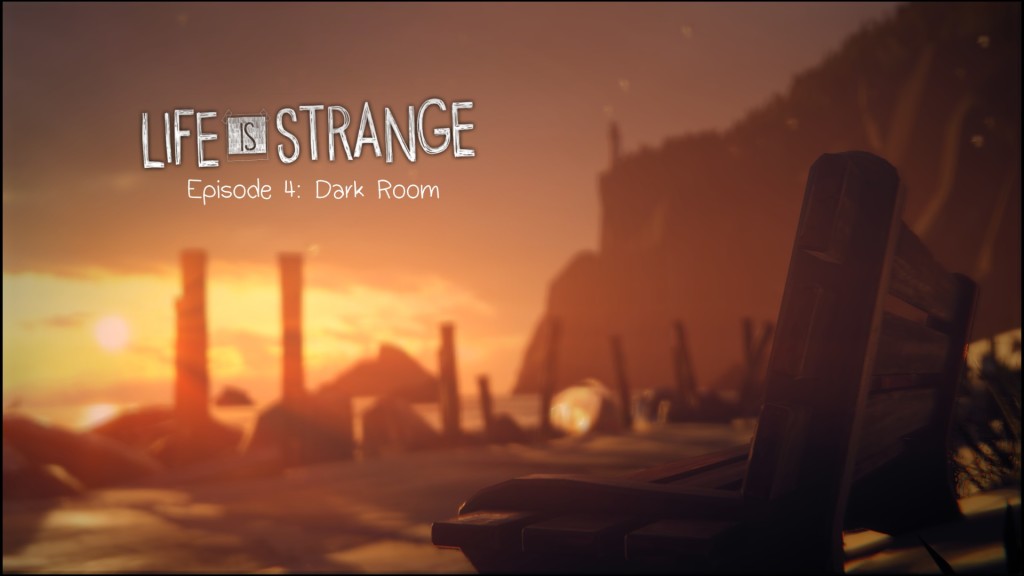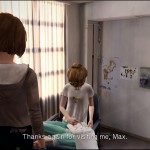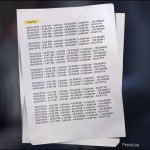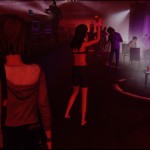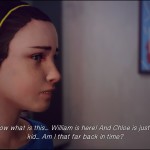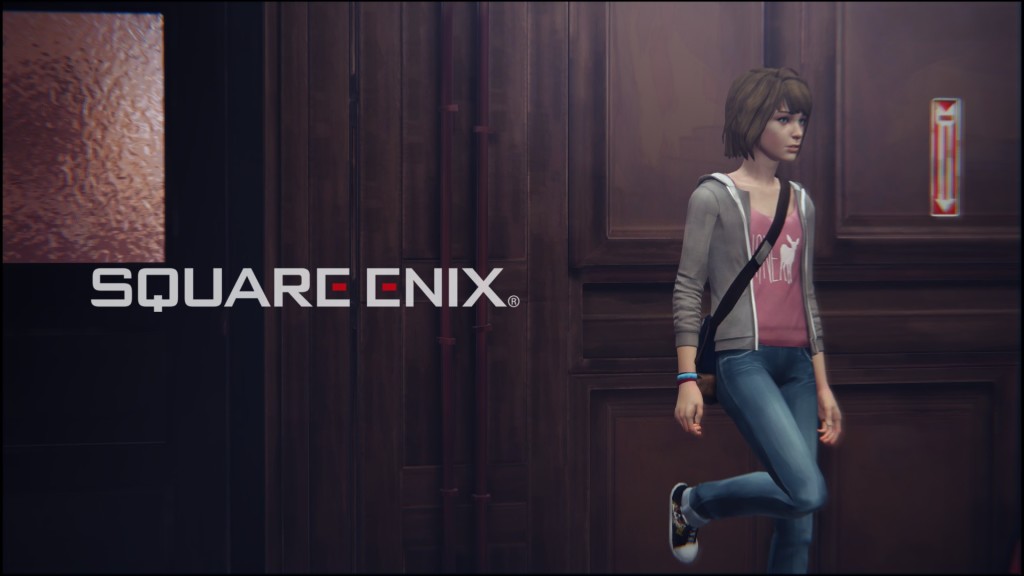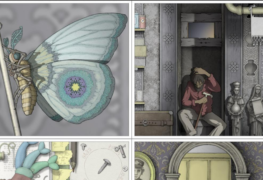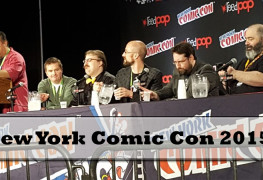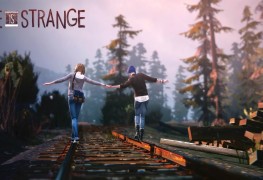PaxSouth is a hub for intriguing and inventive games, and the first two video games from movie studio, Annapurna Pictures, are no exception.
Gorogoa
Gorogoa caught my eye firstly because of the art. It looked like a coloring book brought to life, like a dream you could wade through via computer. I spent a solid half hour diving into the story, figuring out some puzzles with lightning speed and stumbling through others while feeling judged by the character when I got stuck. That said, I can’t wait to get my hands on the entire game!
Designed, developed, and illustrated by Jason Roberts, Gorogoa is a completely unique game. The overall story is equal parts myth and magic as a boy sees a colossal monstrosity in his city and decides to unlock the secrets to finding it. Each gorgeous scene is split into four panels that you can explore through a simple point and click mechanic. Solving each puzzle reveals more of the story. Elegantly simple and perfect for fans enamored of lovely storytelling.
Gorogoa is scheduled to hit mobile devices and Steam in Spring 2017.
What Remains of Edith Finch

I adore morbid games, and when I saw that What Remains of Edith Finch ‘s premise revolves around about different characters dying, I immediately signed up to demo What Remains of Edith Finch.
What Remains of Edith Finch is a collection of short tales about a family in Washington state. As Edith, the player will explore the colossal Finch house, searching for stories. Each story you find lets you experience the life of a new family member on the day of their death, with stories ranging from the distant past to the present day, and culminating with that family member’s death.
In the 20 minute demo, we experienced the final moments of two different family members. The macabre interactive narrative is completely fresh in its storytelling and the attention to detail reminds the player that this title isn’t suited to the run-and-gun. I don’t want to spoil anything for those of you picking it up, but prepare yourself for some feelings. Oh, and remember to breathe.
What Remains of Edith Finch is due out Spring 2017 on Steam and PS4. Check back here, because this is the standout title that we absolutely cannot wait to get our grubby little hands on and review in depth!
Want more PAX South 2017 coverage? All you had to do was ask!
Prisma and The Masquerade Menace, Sundered, and RiME
Minit, Beat Cop, and Strikers Edge
Arms, Splatoon 2, and Legend of Zelda: Breath of the Wild
Monster Boy, Warlock’s Tower, and Has-Been Heroes
As New York Comic Con gets bigger and bigger, it becomes impossible to take it all in, and no matter how well we plan for it, inevitably things don’t work out. Here is our breakdown of one of the fastest going conventions in the United States.
Thursday goals included attending the 88MPH: A Celebration of Back to the Future, a panel about DC Comics imprint Vertigo’s new #1s, attempting to get into the Viz Media/Musashi Kishimoto panel, and finishing out the day at MootCon4 to talk to people about the Game of Theories webseries. While not an entirely adventurous schedule, the sheer amount of people made it impossible to navigate the exhibit hall (or the smaller, craft/creator filled area called The Block) in a timely manner. New York Comic Con was wall to wall cosplayers in different Doc & Marty costumes (and a TON of Rick & Morty costumes as well), some so well done, several double takes were needed to make sure we didn’t accidentally walk by Christopher Lloyd himself. We had to slowly step our way to the Image booth where we met up with comic creator Ivan Brandon for a scheduled interview, before attempting to make headway toward the Funko booth, hoping to get our eyeballs on some of those exclusives! There were many promotional life-size POP! figures to promote the upcoming Smuggler’s Bounty, and it was difficult to tear ourselves away and re-evaluate our plan as the hour grew late. It was here our paths split, with Tushar checking out the Games and Education panel, Kaitlyn calling it a day, and Leia preparing for a long evening of line waiting to spend an hour in the same room as Naruto creator Masashi Kishimoto, before preparing for day two.
 As the weekend progressed, we saw the floors even MORE packed than before and our weary correspondents loaded up their schedule with panels. First, however, Kaitlyn and Leia wandered over to the Audible booth to try out the immersive Locke & Key experience via Oculus Rift, before an interview with Sean Lewis and Benjamin Mackey, newbies in the comic industry. Artist Alley was a sight to behold this year, with greedy fingers reaching for art prints on our way to interview Justin Jordan, and get some stuff signed.
As the weekend progressed, we saw the floors even MORE packed than before and our weary correspondents loaded up their schedule with panels. First, however, Kaitlyn and Leia wandered over to the Audible booth to try out the immersive Locke & Key experience via Oculus Rift, before an interview with Sean Lewis and Benjamin Mackey, newbies in the comic industry. Artist Alley was a sight to behold this year, with greedy fingers reaching for art prints on our way to interview Justin Jordan, and get some stuff signed.
Now despite the name “New York Comic Con,” non-comic media, like television, was there in force too. The folks at Adult Swim were up to their old tricks again with roundtables for Venture Bros, Robot Chicken, and the new miniseries airing soon, Neon Joe, Werewolf Hunter. (You can check out our preview at Adult Swim at NYCC – Neon Joe, Werewolf Hunter). Getting to meet TV personalities like Jon Glaser, Stephanie March, Breckin Meyer and the crazy duo of Doc Hammer and Jackson Publick went exactly as we thought it would go. Antics upon hijinks upon gut busting laughter. It was tough to get through the whole thing without addressing Stephanie March as anything other than “Assistant District Attorney Alexandra Cabot,” but ultimately composure was kept and we found that she, along with the rest of the Adult Swim actor corps, were super cool and friendly people.
TV wasn’t the only non-comic media to make a splash this year. Video games made their presence felt too. If you had (like we did) a bit of trouble getting through the main entrance to the con floor because of a pure sea of concentrated humanity, you were probably going by the Capcom booth. Lining the booth was an army of Street Fighter enthusiasts, and it WAS possible (but not probable) to slither your way in to get a crack at seeing some gameplay from Street Fighter V. The game played faster than its predecessor Street Fighter IV, and you could see some of the classic cast like Karin making their return from the Alpha/Zero series of Street Fighter games. There was a tournament going on as well, so there was always the chance that if you went in to get schooled, it would be public on a lot of large screens.
Square-Enix decided to take the quieter route and had a media suite set up a Shop Studios, just a couple blocks away from the Javits Center. It was nice to get away from the bustle of the con floor for guided demos of their games to small groups of people, and the fact that they fed us definitely did not hurt the experience. Making the rounds through Shop Studios we saw the upcoming Deus Ex: Mankind Divided (check out our preview here), Hitman, Just Cause 3, and the finale to Life Is Strange with Episode 5. The biggest and friendliest surprise though was that Lara Croft: GO wasn’t the only appearance our girl Lara Croft made that day. The full playable demo of Rise of the Tomb Raider looked and played absolutely great.
The Star Wars franchise decided to take an in between approach, setting up their Star Wars Battle Pods outside of the con floor but still inside the Javits Center, making it easy to get to and a beacon of the force as people entered the building. The battle pods let you take command of a few different vehicles from the Star Wars universe, from going on a Death Star bombing run in an X-Wing to trying to hang on for dear life on a speedbike on Endor. Either way, the ride was complete with vibration and pod shakes that one would presumably feel taking your X-wing out of the hangar.
Our last day was spent tying up loose ends, such as taking photos of the creepiest cosplay we could find, picking up more stuff to give away to you guys, and making our last stop at the phenomenal Women of Marvel panel, before shambling off home.
Be sure to check out our other convention coverage and we hope to see you guys in the future! We can’t wait for next year, and leave you with this awesome cosplay video from our friends, SneakyZebra.
In case you haven’t already, don’t forget that we are giving away a bunch of stuff for those of you who didn’t get to attend! Enter below.
Like most of you, I was still reeling from the shock of the end of Life Is Strange Episode 3, where we find out what happens to Chloe by saving her dad from the car accident in our little time-travel adventure. Episode 4 jumps right into the story at that point in the alternate timeline – where William is alive, Joyce never marries David, and Chloe is paralyzed from the neck down from an accident. On the meta level, weird things are still happening like they have been in our “original” timeline in Arcadia Bay that we’ve had for the first 3 episodes.
This is the backdrop Dark Room plunges us into, and is in my opinion, the most emotional episode in the series so far. The episode’s opening is beautiful and sweet as Max gets used to this new alternate reality and new relationship with Chloe, until she (and you) are forced to make a very difficult choice regarding her life. What really impressed me about it was how giving the alternate timeline’s Chloe a severe disability never portrayed her as a victim – there were a number of scenes where Max and Chloe were hanging out and having fun just like we’re used to in the original timeline. And in the background, while you were walking around the Price house without Chloe, what players see is a family surrounded in mountains of debt trying to make ends meet and pay for medical care, showing the very real emotional and financial hardships this kind of tragedy can bring. After agonizing over that choice and rewinding as many times as I possibly could before locking a decision in, I was relieved to see that either choice brought you back our timeline. I’m not sure how this game would even progress without Chloe.
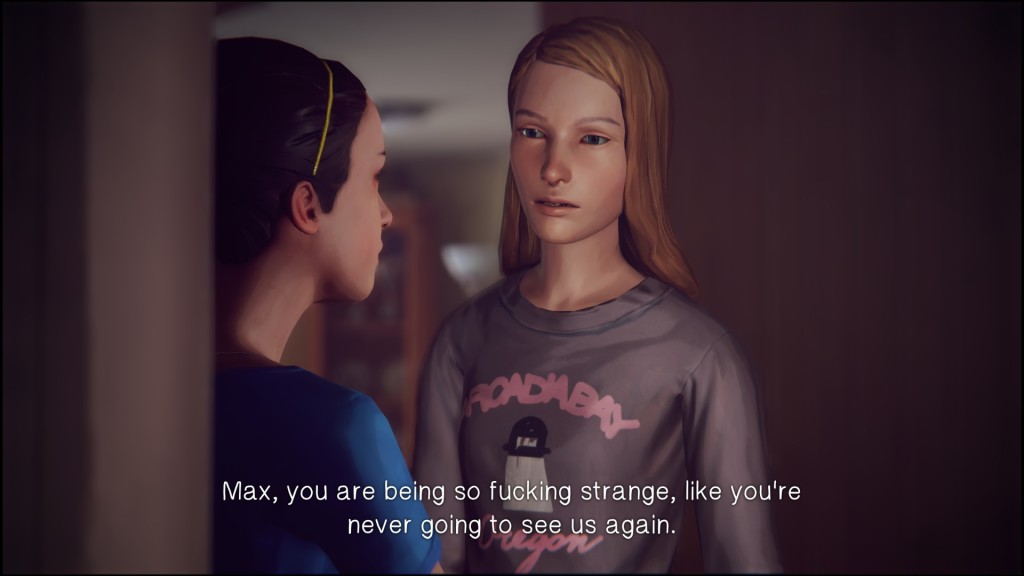 The big “rewind” scene in Dark Room takes place shortly after that, in the form of an encounter with Frank – the not-so-lovable drug dealer, who Chloe loathes and who has ties to her friend Amber. This scene, no joke, took me roughly 30 minutes to get through until I was satisfied with the choices that I made. With over five choice branches and combinations, the majority of which end up very very badly, I was on the verge of outlining my own flowchart before I finally came out on top. Every other option was horrendous. DONTNOD actually furnished a flowchart for that scene in a rare behind-the scenes look, and though while running through that scene I shouted numerous times “WHAT DO YOU WANT FROM ME??” at my screen, it’s really cool to see how complex a (sans rewind) 5 minute scene can be on game’s decision engine. You can check out the flowchart in the gallery below (click or right-click/download to blow it up to full size).
The big “rewind” scene in Dark Room takes place shortly after that, in the form of an encounter with Frank – the not-so-lovable drug dealer, who Chloe loathes and who has ties to her friend Amber. This scene, no joke, took me roughly 30 minutes to get through until I was satisfied with the choices that I made. With over five choice branches and combinations, the majority of which end up very very badly, I was on the verge of outlining my own flowchart before I finally came out on top. Every other option was horrendous. DONTNOD actually furnished a flowchart for that scene in a rare behind-the scenes look, and though while running through that scene I shouted numerous times “WHAT DO YOU WANT FROM ME??” at my screen, it’s really cool to see how complex a (sans rewind) 5 minute scene can be on game’s decision engine. You can check out the flowchart in the gallery below (click or right-click/download to blow it up to full size).
And that complex logic, with all of its twists and turns, broke the fourth wall and spilled over into my real life discussions with people. You see in a lot of other episodic games, the choice engines generally brought you right back to a main timeline with only subtle differences in details with no real alterations on the plot. Dark Room really shows how this game differs from other popular titles like The Walking Dead. You were able to see some of the short term consequence from Chrysalis in Out of Time and Chaos Theory, but Dark Room was the first episode where some real differences took place in the main storyline due to your choices.
I was at work and a friend asked me if I had finished playing Episode 4 yet, and my response was:
“Not yet. I’m still at the part where you’re visiting Kate at the hospital.” He looked at me for a second confused, and asked when that was because he didn’t remember the scene.
“Huh? But in my game Kate died.”
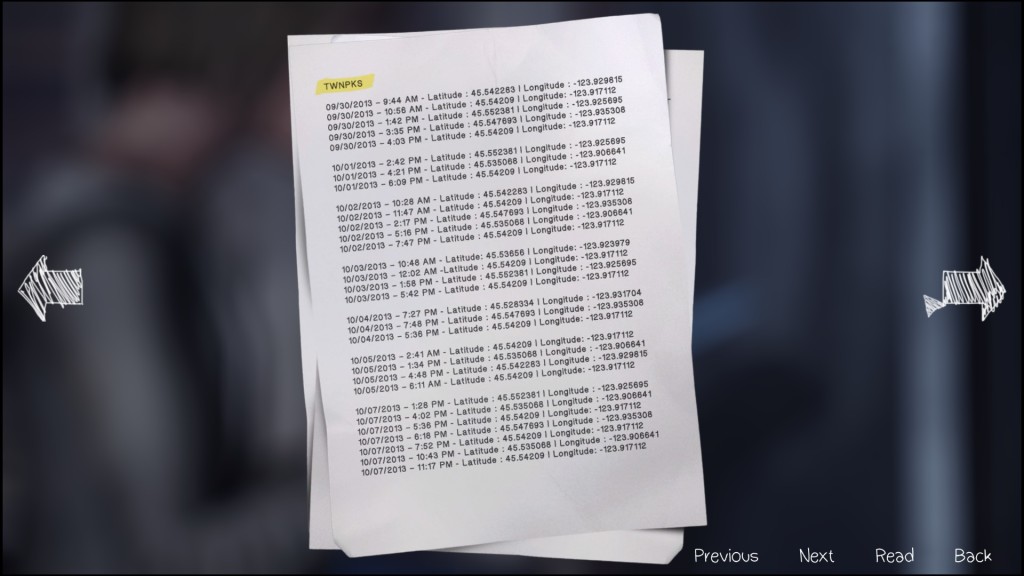 So I had a full and complete scene in my version of the game that he never got to see, because of the differences in a 4-question scene way back when. Consequently he’ll be replaying that, as will I, to see the other potential events that cascade from the other side of that particular coin.
So I had a full and complete scene in my version of the game that he never got to see, because of the differences in a 4-question scene way back when. Consequently he’ll be replaying that, as will I, to see the other potential events that cascade from the other side of that particular coin.
The new mechanic in Episode 4 was possibly one of my favorites. After collecting a slew of clues from around Blackwell and Arcadia Bay, Max and Chloe (i.e. you) go to work on an evidence board matching up license plate numbers, code names and GPS information to get answers for what’s going on. Matching the right clues got you to the next bit of the mystery – and when it’s over, you get a sense of CSI pride for making it work.
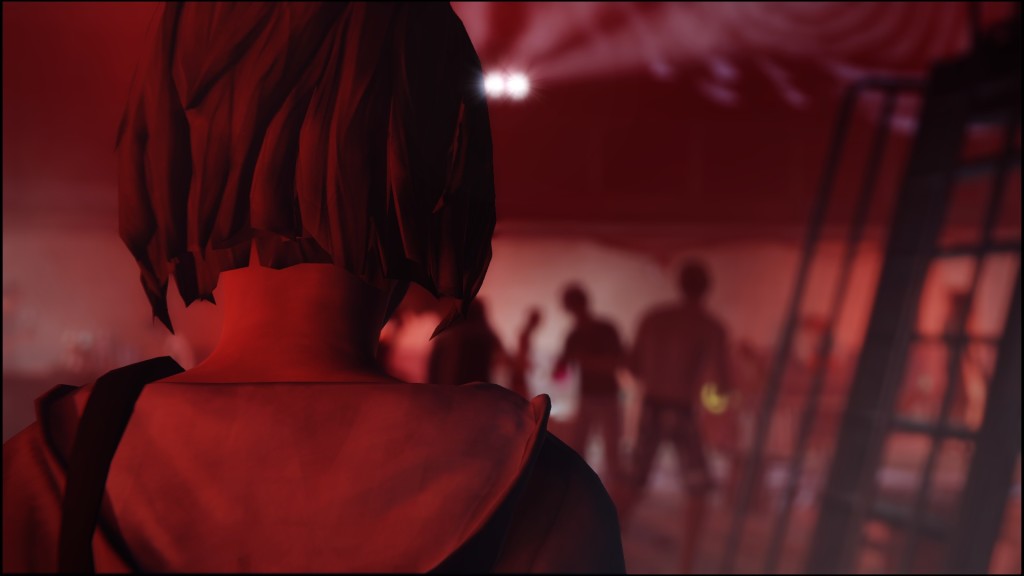 The culmination of the episode was a collection of scenes that was some of the most tense and harrowing sequence of events I’ve seen in a video game. After assembling the clues and investigating what happened to Rachel, Max and Chloe find information find the titular dark room in what was one can only be described as legitimately frightening. Scenes around the famed Vortex Club party follow where Max is looking to get answers. I’m not going to tell you what happens, because it’s something you have to see for yourself and honestly I’m not sure I have the right words (I know, and I call myself a writer) to describe the shocking and quite frankly, unsettling conclusion to the episode.
The culmination of the episode was a collection of scenes that was some of the most tense and harrowing sequence of events I’ve seen in a video game. After assembling the clues and investigating what happened to Rachel, Max and Chloe find information find the titular dark room in what was one can only be described as legitimately frightening. Scenes around the famed Vortex Club party follow where Max is looking to get answers. I’m not going to tell you what happens, because it’s something you have to see for yourself and honestly I’m not sure I have the right words (I know, and I call myself a writer) to describe the shocking and quite frankly, unsettling conclusion to the episode.
Having started on the journey with Max and Chloe way back in Episode 1, we see the wow factor of the mechanics make way for storytelling, and subsequent episodes show what it can accomplish through the video game medium. DONTNOD hasn’t shied away from making the audience emotional and uncomfortable, and situations in-game have made me more uncomfortable that some actual decisions I’ve had to make in real life. Dark Room continues that trend with a hard crescendo and takes a very dark turn in plot and character development. The sheer number of events, both personal and meta, with the knowledge that there’s only 1 day left for Max to fix this adds a lot of anticipation and a sense of urgency while finishing this chapter, and continue to deliver with endgame twists and turns.
Setting up those kind of logical trees with this kind of depth is not easy. Everything has to be mapped out down to the last detail for it to work smoothly and have real short and long-term consequence. How do I know how hard that is? Because over a decade ago as a 19 year old sophomore in my Digital Logic class for engineering school, mapping out the logic for something as simple as the coin return on a damn vending machine took a couple retries to get right.
The release date for the upcoming and final episode is next month on October 20th, and if you haven’t gotten a chance to play this series through then I highly recommend that you do before Episode 5: Polarized comes out to play.
- Visiting Kate in the Hospital
- Opening Title
- Alternate timeline Max and Chloe
- Alternate timeline Chloe
- Detective work with GPS
- Postcard from Victoria
- Nathan Prescott for you.
- Viral video and revenge
- Binders hinted at since Episode 1
- Max comforting Chloe
- Double moon in Arcadia Bay
- Vortex Club Party
- Vortex Club Party dancing
- Ominous things
- Max and Chloe as kids
- The Frank Decision Tree
- Chloe and WIlliam
- Time travel back to kid Max
Tushar Nene
Staff Writer
@tusharnene
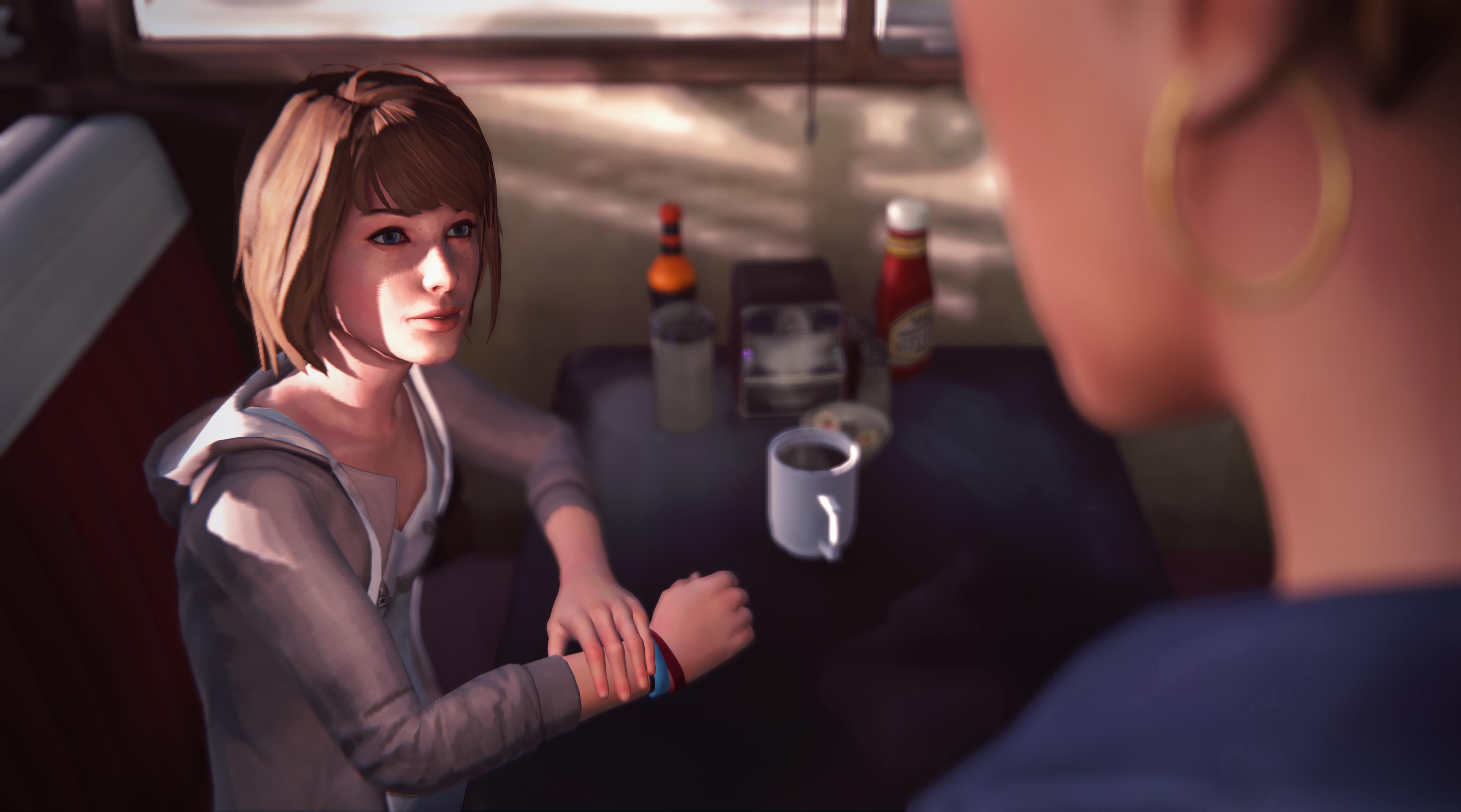 “So a lot of people ask us ‘If you can rewind the game, doesn’t that mean that you can cheat? Isn’t that the same as reloading the save?’ It would be if it was badly designed.”
“So a lot of people ask us ‘If you can rewind the game, doesn’t that mean that you can cheat? Isn’t that the same as reloading the save?’ It would be if it was badly designed.”
That was what Square-Enix’s Adam Phillips had to say about the luxury of choice in their current series Life is Strange. And that statement is 100% correct. I’m in my second playthrough now of episode 1, Chrysalis and am not having any less fun trying different choices I take with Max in her exploration of her newly found powers over time. The beauty of it is that there’s no correct answers in the game, and even though the short term results of the decisions made are simple enough to see, the long term and meta effects aren’t so easy to spot.
Just like life. Strange… right?
I was able to sit down with Square-Enix and DONTNOD Entertainment at PAX East last week to get a preview of Life is Strange episode 2, Out of Time to see some spoiler-free gameplay. We were able to see some of the longer-than-short-term consequences of one of the pivotal decisions from Chrysalis – whether or not to take the blame for Chloe’s stepfather finding her smoking weed, resulting in being in hot water yourself or Chloe taking an angry backhand.
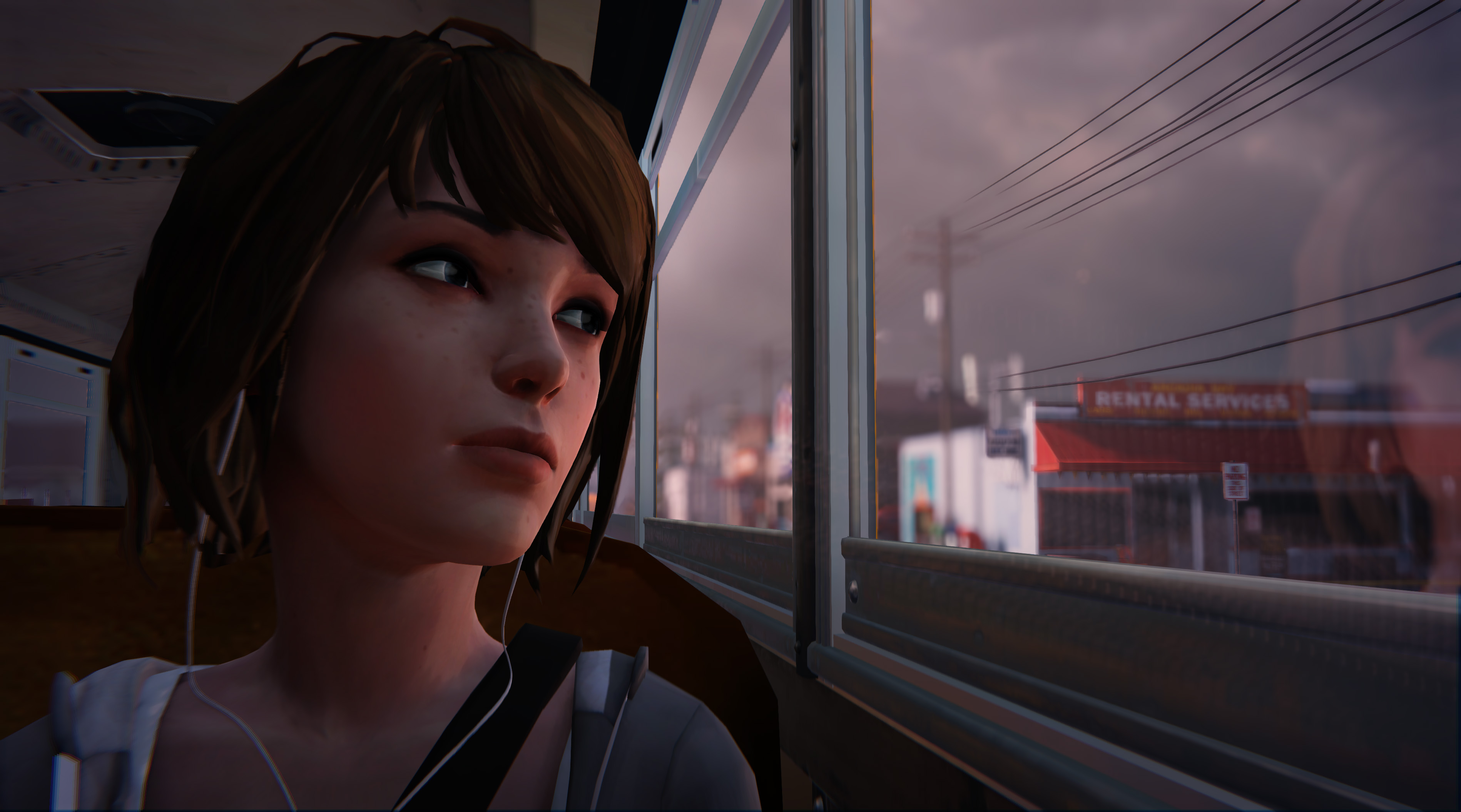 The game picks up on the day after Max finds discovers her gift (1 episode, 1 day) and the scene we got to play through was Max meeting Joyce, Chloe’s mother, at the diner where she has been working for years. You have the choice of telling Joyce or not that Chloe’s stepfather struck her, but not every playthrough has that option. We were playing episode 2 using the input from episode 1 that Chloe hid in the closet and watched Chloe get struck, and that’s why this and other choices are available to us now. The game keeps track of every decision you’ve made, and offers shifts in the storyline accordingly, guaranteeing a number of playthroughs which are all different. “It really is a network,” was how the choice system in the game was explained to us. “There are in this game some binary switches, like if you do this that happens, but in this game there are actually combination switches as well.” This won’t affect the overall story of the game but it will affect the way the game progresses. “More like branches they’re vines going up a tree, so they all go in the same direction, each one is just slightly different.”
The game picks up on the day after Max finds discovers her gift (1 episode, 1 day) and the scene we got to play through was Max meeting Joyce, Chloe’s mother, at the diner where she has been working for years. You have the choice of telling Joyce or not that Chloe’s stepfather struck her, but not every playthrough has that option. We were playing episode 2 using the input from episode 1 that Chloe hid in the closet and watched Chloe get struck, and that’s why this and other choices are available to us now. The game keeps track of every decision you’ve made, and offers shifts in the storyline accordingly, guaranteeing a number of playthroughs which are all different. “It really is a network,” was how the choice system in the game was explained to us. “There are in this game some binary switches, like if you do this that happens, but in this game there are actually combination switches as well.” This won’t affect the overall story of the game but it will affect the way the game progresses. “More like branches they’re vines going up a tree, so they all go in the same direction, each one is just slightly different.”
To get used to the “keep your knowledge and stuff” part of the time rewind mechanic, you’re forced to guess everything that happens within 10 seconds at the diner and everything that’s in Chloe’s pockets. Of course you’re not a mind reader so the only option is to guess wrong, see the real answer, rewind and prove the Chloe your “superpowers” are real. It works as this game’s take on quick time button events, where you have to get the whole sequence right or rewind time and start over.
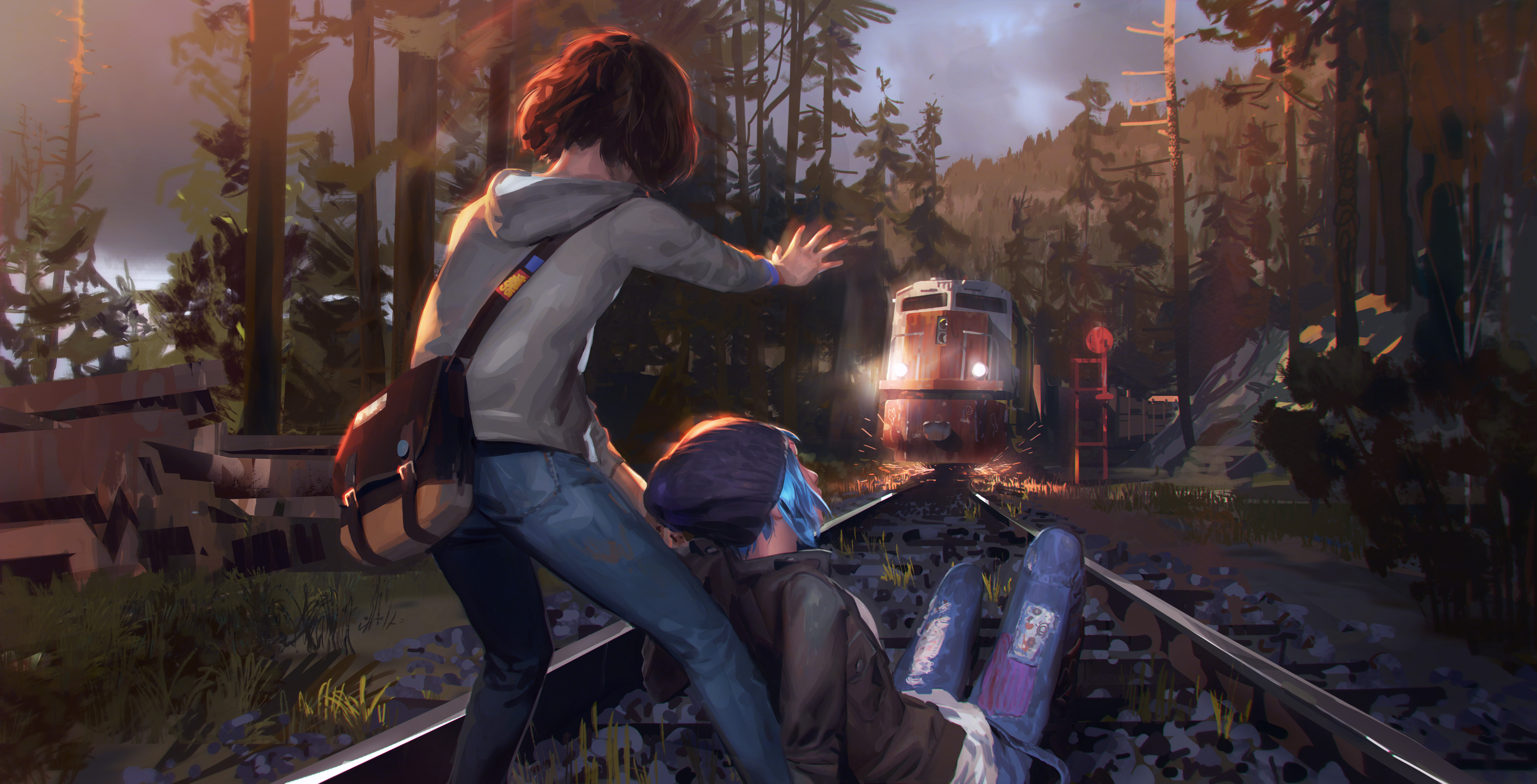 I’m really looking forward to see how my different savegames affect my playthrough for episode 2, and the way this is set up we’ll be getting increasing levels of meta consequences for seemingly small choices we made earlier on.
I’m really looking forward to see how my different savegames affect my playthrough for episode 2, and the way this is set up we’ll be getting increasing levels of meta consequences for seemingly small choices we made earlier on.
The soundtrack which thoroughly impressed me in Chrysalis maintains its deliciously modern indie feel, with artists like José Gonzaléz, Syd Matters and alt-J on the score for both background music and the tracks Max listens to. “It was really important when Max put her earbuds in that you heard the sound dull down as she pressed play. What happens when you hear a licensed track? It grounds you in reality.” It’s true, and goes a long way in helping continue to set the tone and emotion of Max and Chloe’s adventures in Arcadia Bay.
I asked creators Raoul Barbet and Michel Koch from DONTNOD about why episodic games are finding so much success next to huge triple-A 80-90 hour behemoths. “It’s the way we’re playing games nowadays. We have less time I think, and a short experience is something you can really enjoy between two stations of one really huge game. Sometimes those short experiences of an episode of a game or a short game like Journey can be interesting to play because you can play it in one session.”
Of course they mentioned that also inherent in episodic games is the anticipation and expectation for the next one to come out to see what happens. And that part is working.
Thankfully we don’t have too much longer to wait. Life is Strange episode 2, Out of Time will be released this month on March 24th, and I’ve got my season pass ready to pull it down and see what happens to Max and Chloe next.
[oh, and P.S., I asked about porting this to tablets because I think it would work great with the UI and control scheme – and I can officially say it hasn’t been ruled out]
Tushar Nene
Staff Writer
@tusharnene
Before I get into it let me just start by saying this – I don’t generally do formal game reviews. But titles like this are why I will always have love for video games.
Back in October at New York Comic Con I had the pleasure of attending Square-Enix’s press party, where they graciously fed me and kept me on a steady stream of vodka cranberries as I made the rounds to check out theirr new wares. There were things I expected to see like the new editions of their mainstays Final Fantasy and Tomb Raider, but there was an interesting demo they had over in the corner. The demo was down at the time, but they have me some links to the demo online. And a few minutes of demo was all it took to sell me on Life is Strange. Check out the release preview just below:
What you just saw? This is what the game feels like while playing it.
Released in late January, Life is Strange represents S-E’s first foray into episodic adventure games, a genre that his been picking up steam since 2012 saw Telltale’s The Walking Dead hit consoles. Since then they’ve exploded with titles, and this style of game found continued success with the formula, with Telltale having just released opening episodes of Tales from the Borderlands and Game of Thrones late last year, with episode 2 of the latter being just released on February 3rd.
But this is altogether different.
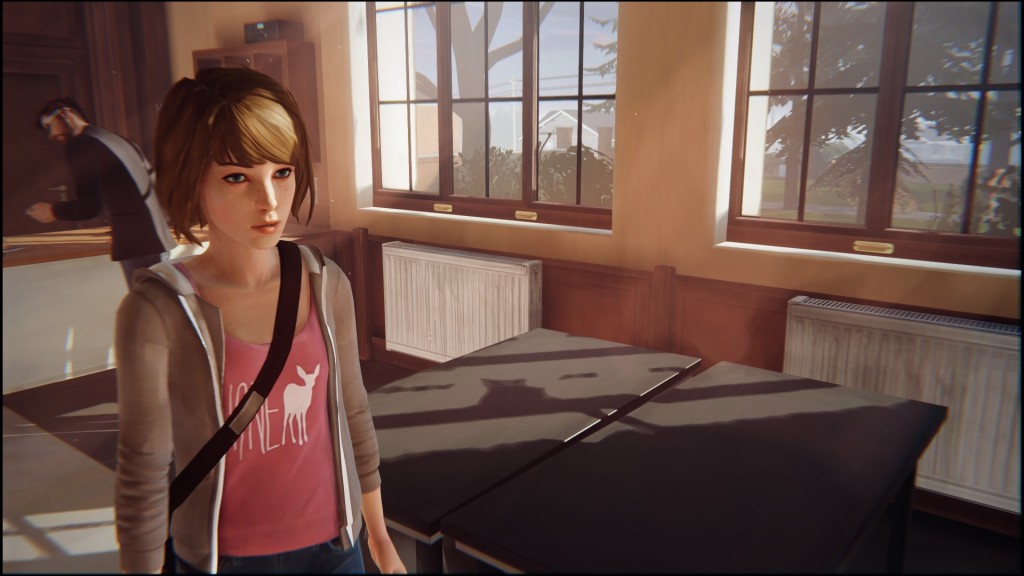 Life is Strange puts you in the shoes of 18 year old Max Caulfield, a high school student in the photography program at Blackwell Academy, having returned to her home town of Arcadia Bay, Oregon after five years. A shy and introverted young woman, she can always be found toting her vintage polaroid camera while avoiding the race of being one of the cool kids. It’s while hiding in the bathroom to get herself together after a particularly rough morning that she witnesses a violent crime – and learns that she can rewind time in the process.
Life is Strange puts you in the shoes of 18 year old Max Caulfield, a high school student in the photography program at Blackwell Academy, having returned to her home town of Arcadia Bay, Oregon after five years. A shy and introverted young woman, she can always be found toting her vintage polaroid camera while avoiding the race of being one of the cool kids. It’s while hiding in the bathroom to get herself together after a particularly rough morning that she witnesses a violent crime – and learns that she can rewind time in the process.
This mechanic is available at every juncture in the game where Max has to make a decision, informing the player each time that their selected action has consequences. The twist to it, however, is that even after rewinding time, Max retains the knowledge and any inventory she picked up. In this way the player can choose an action, find that it has horrible consequences, and with that knowledge rewind time to change their path.
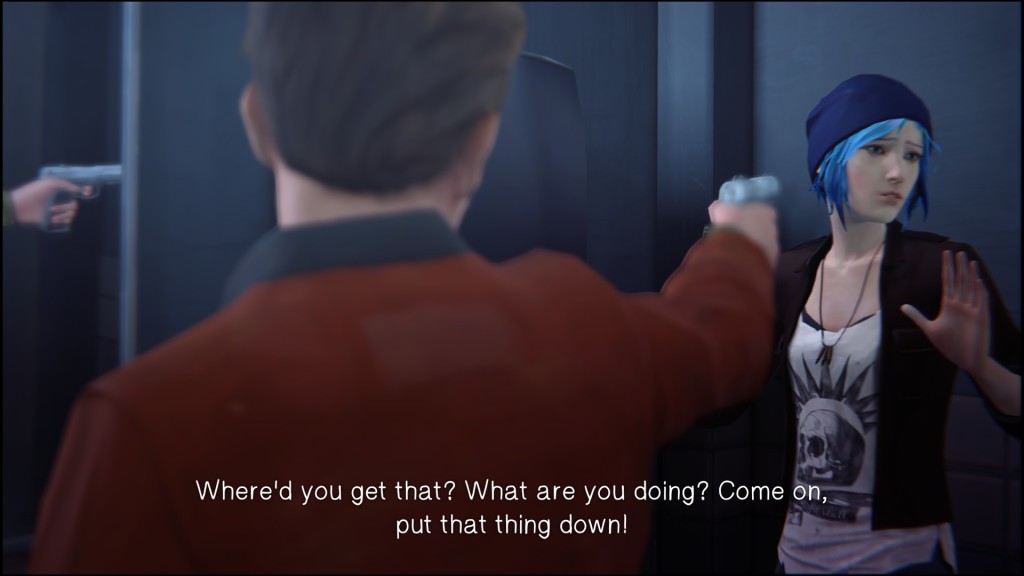 As an example, in one scene Max is taking folders from a high shelf to rummage for information. When she gets the files they fall into an oil slick on the floor. So do you read the files and leave them, as well as evidence of your snooping? Rewind time to not take them at all? Or read the information then rewind time to hide the evidence? And that theme is what fuels the game. Are you happy with the choices you’ve made in life? What would you do if you could go back?
As an example, in one scene Max is taking folders from a high shelf to rummage for information. When she gets the files they fall into an oil slick on the floor. So do you read the files and leave them, as well as evidence of your snooping? Rewind time to not take them at all? Or read the information then rewind time to hide the evidence? And that theme is what fuels the game. Are you happy with the choices you’ve made in life? What would you do if you could go back?
Throughout the narrative Max is challenged with obstacles that we’re not used to seeing in a lot of other games. There’s her classmate Kate who has more secrets than she lets on, teenage drama with the school’s “mean girls,” the school security guard that never seems to cut her any slack, and the entitled trust fund babies that can buy life on easy street at the expense of others (Max included). We’re not knights of the realm, we’re not hiding from dragons or trying to scavenge for another night running from zombies. This is an ordinary high school kid that has discovered something extraordinary about herself. And it’s that aspect of the game that makes it easy to buy into. Everyone has memories of rough times in high school – whether it be fitting in, finding one’s own way, dealing with being an outcast or problems with authority. Everyone at least once has imagined they were invisible or that they could take back the things they’ve done. Regardless of when your graduation was, there’s a simple nostalgia to Life is Strange, almost dark and sweet at the same, that gives players a connection to Max and the story. Max also keeps a diary recounting all of her exploits and decisions as they are made. The diary itself serves as a great vehicle for developing Max, putting her thoughts to the page and giving the player a bit more insight into the character.
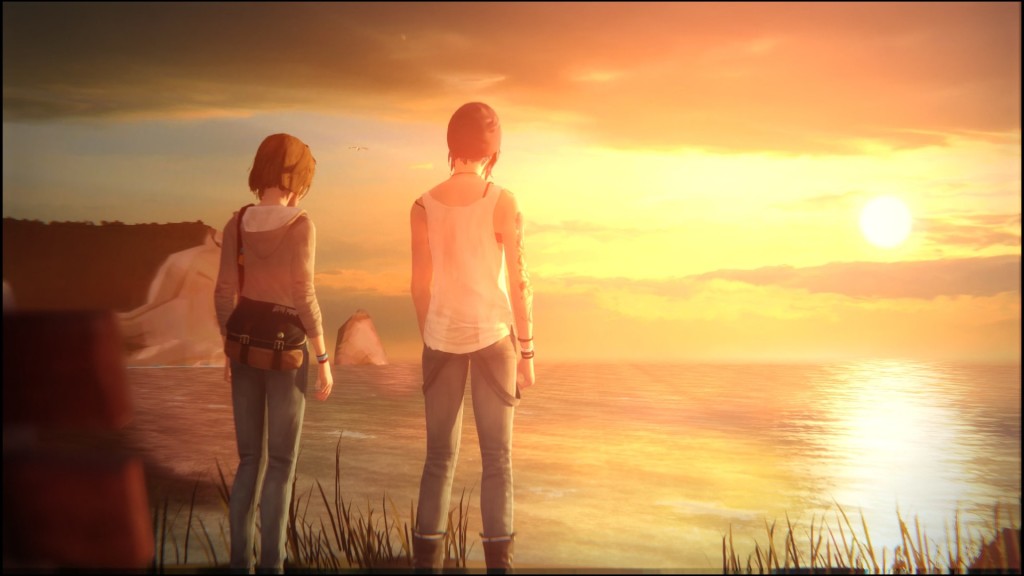 As the plot progresses, we find Max reunited with her former best friend Chloe who she can barely recognize, the mystery behind the disappearance of Blackwell student Rachel, and what can only be described as blackout premonitions of impending doom. This first episode gave us a small taste of Max’s life in Arcadia Bay and I’m hoping sets us up well for Episode 2 in March.
As the plot progresses, we find Max reunited with her former best friend Chloe who she can barely recognize, the mystery behind the disappearance of Blackwell student Rachel, and what can only be described as blackout premonitions of impending doom. This first episode gave us a small taste of Max’s life in Arcadia Bay and I’m hoping sets us up well for Episode 2 in March.
The game itself is painted on a beautiful hand drawn backdrop depicting the Pacific Northwest in a way that’s colorful and dark at the same time. That’s accompanied with songs by Syd Matters, Mogwai, and alt-J as part of a soundtrack that sets the mood of every scene on every level. The whole experience makes it nearly impossible not to be drawn into it all. And I’m hoping for more of the same in Episode 2 in March.
Square-Enix and Dontnod deliver an enthralling title with a deliciously indie feel that leaves players with questions and the desire to play more to find the answers. Here’s a few more shots that make good use of the Unreal engine before i sign off.
Tushar Nene
Staff Writer
@tusharnene









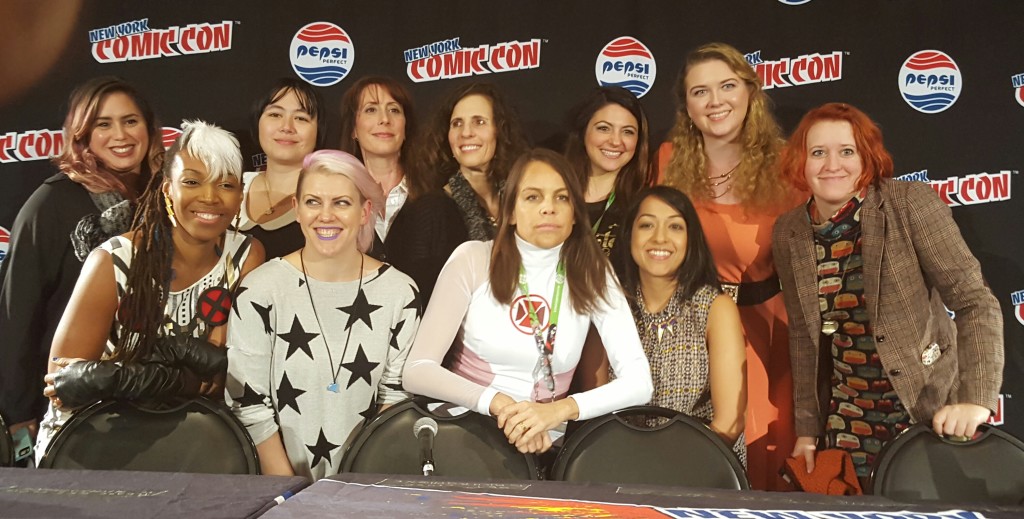
 Powered by Gleam
Powered by Gleam